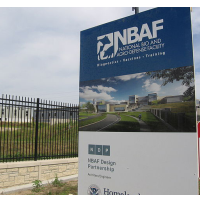Why is Homeland Security Moving its Animal Disease Research Lab to a Place Hit by Tornadoes?
 National Bio and Agro-Defense Facility—Credit: Kgwo1972 - Own work via Wikipedia
National Bio and Agro-Defense Facility—Credit: Kgwo1972 - Own work via Wikipedia
A high-level government research laboratory for the study of deadly animal diseases that is housed on a remote island to lessen the chance of spreading disease is being moved. In contrast to the old site, the new facility is vulnerable to tornado damage and makes it likely that diseases will be released into the environment.
The $1.25 billion National Bio and Agro-Defense Facility (NBAF) will be operated by the Department of Homeland Security (DHS) on the campus of Kansas State University in Manhattan. It’s replacing a facility located on Plum Island, off New York’s Long Island. It was put there in 1954 because it’s far from agricultural facilities and the prevailing winds blow out to sea, and would take any outbreaks away from land.
NBAF, while more convenient to the livestock that carry diseases to be studied at the lab, sits in the path of Tornado Alley, a large stretch of the Midwest vulnerable to violent storms. In 2008, a portion of Kansas State was hit by a tornado, resulting in damage to the school’s nuclear reactor building and wind erosion lab. A breach such as that at NBAF would result in animal diseases being released into an area teeming with livestock.
Laura Kahn at the Bulletin of Atomic Scientists wrote “it is absolutely mind-boggling that Homeland Security has decided to move the lab … smack in the middle of cattle country and Tornado Alley.”
Kahn says the facility will “include a biosafety level 4 lab, meaning one designed to handle deadly and exotic pathogens for which no vaccines or treatments exist. Not surprisingly, there has been a lot of controversy surrounding the lab’s move to Kansas. Ranchers and farmers in the area are understandably worried, while local officials are eager for the jobs and investments the lab will bring.”
Kahn reported that a 2010 National Academy of Sciences study showed NBAF would have a 70% probability of releasing foot-and-mouth disease during its 50-year lifespan.
Two years later, she wrote, the “National Research Council evaluated Homeland Security’s revised proposal and found considerable improvements in lab construction design that lowered the 50-year risk to below one percent, but this extremely low probability of accidental viral release was based on Homeland Security’s unsupported, overly optimistic estimates of human error rates.”
-Noel Brinkerhoff, Steve Straehley
To Learn More:
The Next Epidemic, Brought To You by the U.S. Government (by Laura Kahn, Bulletin of Atomic Scientists)
5. . .4. . .3. . .2. . .1. . . Launch! (Mechanical & Nuclear Engineering News)
U.S. Government Wants to Move Bio-Defense Lab from New York to Kansas (by Noel Brinkerhoff, AllGov)
- Top Stories
- Unusual News
- Where is the Money Going?
- Controversies
- U.S. and the World
- Appointments and Resignations
- Latest News
- Trump to Stop Deportations If…
- Trump Denounces World Series
- What If China Invaded the United States?
- Donald Trump Has a Mental Health Problem and It Has a Name
- Trump Goes on Renaming Frenzy






Comments